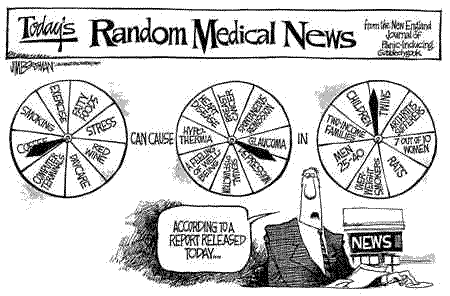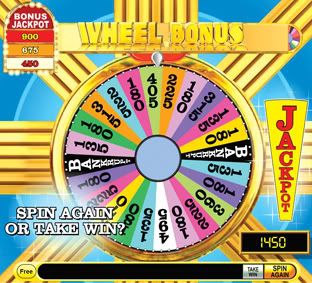
The cartoon above was first published in a newspaper in the
This cartoon uses both images and words to push this point. There are many ways that the words alone emphasize the author’s point. The most obvious is the title: “Today’s Random Medical News”. This tells you that the author feels that the medical news being released is basically pulled out of a hat. The subtitle on the right-hand side is a use of symbolism and parody. It is making fun of The New England Journal of Medicine, a prominent journal of new findings in the medical field that is commonly used as a reference for medical reports in the news today. The subtitle states that it is a journal of “panic-inducing gobbledy-gook.” Without the proper medical training that is exactly what it can become.
The imagery being used helps imply the specific media that the author is talking about, but it is also a use of symbolism and analogy. The image of a white, middle-aged male in a suit and tie, holding papers leads you to believe that he is a television news anchor. This makes the subject focused on television news reports. The use of the spinning wheels with pointers, and different items on  them is symbolic of a game show. Some game shows, like “The Price is Right” and “Wheel of Fortune”, are based on the random spinning of a wheel. By using this symbol, in combination with specific medical terms, shows the randomness that seems to come with some of the news reports these days. In the cartoon the man even has his finger on a button, to cause the wheels to spin and see where they stop for the day. The words listed on the wheels are also used to emphasize the randomness of the stories. The words range from smoking to exercise, breast cancer to a feeling of well being, and two-income families to rats; with most of these match ups being totally ridiculous.
them is symbolic of a game show. Some game shows, like “The Price is Right” and “Wheel of Fortune”, are based on the random spinning of a wheel. By using this symbol, in combination with specific medical terms, shows the randomness that seems to come with some of the news reports these days. In the cartoon the man even has his finger on a button, to cause the wheels to spin and see where they stop for the day. The words listed on the wheels are also used to emphasize the randomness of the stories. The words range from smoking to exercise, breast cancer to a feeling of well being, and two-income families to rats; with most of these match ups being totally ridiculous.
There is also a bit of pathos being used in this cartoon. The subtitle’s mention of “panic-inducing” appeals to the anxiety that most people have with their health. In these times our culture is trying to be so health conscious, the when new reports come out we all rush to follow the recommendations, or worry if we are at risk. Also the anchorman’s facial expression evokes emotion. His straight face and turned down mouth seems to be disappointing or disapproving, like even the anchorman doesn’t believe himself anymore.
All of this rhetoric is implying that issues come up with medical news reports. One problem that can arise is a misunderstanding of medical reports. News reporters aren’t trained in medical jargon, and that can cause a mistranslation of what the medical report is actually stating (Heussner xi). Another problem is when medical news is announced too soon. Sometimes the media reports a medical “breakthrough” before any tests can be done to confirm the findings (Heussner 7). There are also issues of news reports being made on the basis of sources that aren’t credible. This can cause warnings of medical illnesses and risks that aren’t true (Heussner 13). And last is something I think we all know about, the “spin” that reporters put on stories to make them more interesting (Heussner 30). This also leads to a mistranslation of the facts.
All of this can lead to mental and physical problems in the people that take these reports to heart. Premature reporting of new treatments can cause people to try dangerous things. In 1979 a news report came out about the use of snake venom in treating multiple sclerosis. Tons of people ran to try this potentially lethal drug, that wasn’t even FDA approved (Heussner 45). Sources that are not credible tend to give a lot of false hope to people; and when discovered, dashes people’s dreams and gives them depression. Also in 1979, a report was made about a boy with cerebral palsy running a 6.2 mile race. This gave many people with cerebral palsy great hope. The story was found to be false (Heussner 68), but how many people with cerebral palsy tried to run before this was found out?
This cartoon is a very well-rounded piece of rhetoric. It is very effective at making its point. The author of this cartoon uses a variety of different things, from a plain statement of it, to imagery to support the words. By doing this the idea of random, unsubstantiated, panic-inducing news reports is hard to ignore. Whether we look online, on television, or in a newspaper, we will find out about new medical “breakthroughs”. We need to be careful to try to find out more from credible sources before we take any action about them. Try to always be skeptical of news reports, to keep your hopes from getting too high before all the facts are known. And if there is a report that you are interested in, always contact a credible source to confirm or deny the story, such as your doctor, or a government agency (Heussner 181).
Works Cited:
Heussner R. Warning: The Media May Be Harmful To Your Health!

No comments:
Post a Comment